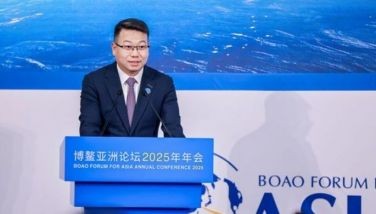MMDA is NOT MMC

There was a recent announcement that the Metro Manila Development Authority was going to celebrate its 40th founding anniversary. This error in historical interpretation is possibly due to the mistaken perception that the Metro Manila Commission (MMC), established in 1975, is the same body as the MMDA established by Republic Act 7924 in 1995.
In 1975, in the midst of martial law, Ferdinand Marcos established the Metro Manila Commission to “act as the central government” in the Metro Manila region. The new body had political powers including control over the local government units and the power to “levy and collect taxes and special assessment.”
Although it had specific powers over local governments and was a political unit, the MMC head was appointed and not elected. The appointed head was Imelda Romualdez Marcos who was given the title of MMC Governor.
After the People Power Revolution in 1986, when the Marcos family fled into exile, the new government under President Corazon Aquino appointed Joey Lina as OIC Governor, it was a caretaker position until a decision could be made on the final disposition of the MMC.
The following year, Lina resigned in order to run for the Senate. Then Makati OIC Mayor Jejomar Binay was appointed OIC Governor of MMC. A year later, Binay resigned in order to run as Mayor of Makati.
At that time I was the head of the Presidential Management Staff. I was appointed as OIC Governor of MMC concurrent with my other position. It was understood that I would stay as OIC Governor only as a transition head. I ended up staying in my two concurrent positions for a period of two years. It was clear to me, that under a democratic system, any official that had political control over other elected officials and had taxing powers needed to also be an elected official. However, this was a much debated issue at that time.
Then in 1990, President Corazon Aquino abolished the MMC and established the Metro Manila Authority (MMA) which would be headed by one of the elected mayors in the Metro Manila region. The MMA was also expected to serve as the Regional Development Council (RDC) for the Metro Manila Region.
The Metro Manila Council, composed of all the mayors in the region, was supposed to serve as the co-ordinating and semi-legislative body. However, the problem was that the head of the MMA had no coercive powers over the other mayors. The other problem was that the MMA was principally financed by contributions from the other cities and municipalities which could [and did] withhold their contributions if they disagreed with the Chair of the MMA.
Since there was already a functioning Senate and House of Representatives, a bill was introduced to set up a Metro Manila body. The final law was passed in 1995 creating the Metro Manila Development Authority, a very different body from the Metro Manila Commission.
Metro Manila Development Authority
The Metro Manila Development Authority (MMDA), as promulgated in Republic Act 7924 has a difficult and often contradictory mandate. This contradiction is evident in Section #3: Declaration of Policy and Objectives:
“It is the policy of the State to treat Metropolitan Manila as a special development and administrative region, and to delineate and consider certain basic services affecting or involving Metro Manila as metro-wide services, the delivery of which the Authority shall plan , supervise , regulate, monitor, coordinate or implement where appropriate, in conformity with national government policies without prejudice to the autonomy of the local governments affected.”
The law recognizes Metro Manila as an administrative region and gives MMDA the power “to regulate” but at the same time guarantees the autonomy of the local governments. In effect, the superior body is the local government which can override any MMDA decision if the LGU feels its autonomy has been violated.
Again in Section #7: Powers and Functions: “ The Authority shall perform, planning, monitoring, coordinating and implementing functions where appropriate, and in the process, exercise regulatory and supervisory authority over the delivery of metro-wide services, within the Metro Manila area, and in conformity with the national government policies without diminution of the autonomy of the local government concerning purely local matters.”
The MMDA is tasked to formulate and implement “policies, standards, rules, regulations, programs and projects, to rationalize and optimize urban land use and provide direction to urban growth and expansion, the rehabilitation and development of slum and blighted areas, the development of shelter and housing facilities and the provision of necessary social services thereof.”
The MMDA is caught in a “Catch 22” dilemma. It may have the mandate but without taxation powers or even its own IRA, the Authority does not have the financial resources to fulfil its mandate. This is the reason that the National Government, which has the financial resources, is forced to take over providing services that are strictly Metro Manila affairs.
At the same time, even if MMDA has the resources, it cannot rationalize and regulate urban land use and provide direction to urban “urban growth and direction” without “infringing on the autonomy of local governments”, as provided in the law.
Metro Manila Government
I have often pointed out that Metropolitan regions all over the world are composed of cities and/or districts; bu,t they all have a sing metropolitan regional government. Some clear examples are Tokyo ,Bangkok, Jakarta and London. New York City is divided into five boroughs or counties – Manhattan, Bronx, Queens, Brooklyn, Staten Island. Each area has its own set of elected officials. However, there is one New York City Mayor and Council who are elected.
President Widodo of Indonesia is the former Governor of Jakarta. The moist talked about successor to UK Prime Minister Cameron is the present Lord Mayor of London.
If the Philippines is not prepared to shift to federalism, lawmakers must accept that there is an urgent need, in Metro Manila, to centralize and rationalize traffic management, environmental control, urban land use, waste management, flood control and economic development. If there is no central body to perform these functions, then the national government will be the de facto Metro Manila regional government. The regional head and members of its legislative body must be elected in order to have the support of the citizens of the region and the moral and legal authority over local governments.
It is time for an elected Metro Manila government.
Adult Writing Class
The Personal Essay with Paulynn Paredes Sicam on November 21, 2015 (1:30-5:30pm) at Fully Booked Bonifacio High Street. Paulynn Paredes Sicam is a journalist and editor. She writes a weekly column for the Philippine Star. For registration and fee details contact 0917-6240196/writethingsph@gmail.com.
* * *
Email: elfrencruz@gmail.com
- Latest
- Trending



























